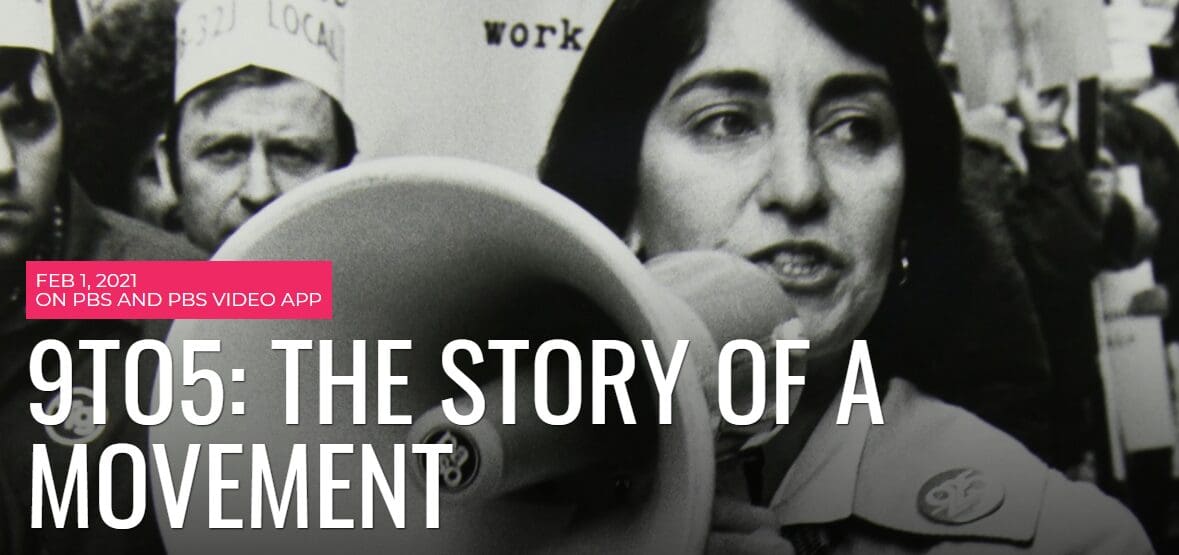The Unfinished Story of Women at Work: 9to5 Yesterday, Today the PRO Act

If you’ve never had to make coffee for your boss, it’s thanks to women who organized in the 1970s. And while the electric typewriter is no more, how women of that era organized is relevant—to current battles like organizing Big Tech, building care infrastructure and winning labor reform by passing the Protecting the Right to Organize (PRO) Act—so women can form and join unions now without fear.
A new documentary, “9to5: The Story of a Movement,” captures the history of an organization started by a group of secretaries in the 1970s, and their sister union, SEIU District 925, and offers powerful insight for us today.
They were the biggest sector in the workforce, but women office workers in the 1970s were seen as servants or, like the wallpaper, they weren’t seen at all. The 9to5 organization changed the culture by using creative tactics like public awards for horrible bosses to name and shame bad behavior. They used humor to call it what it was: ridiculous and unacceptable.
The organization became a cultural phenomenon, with a movie starring Jane Fonda. It inspired Dolly Parton’s iconic song.
9to5 developed leaders from the bottom up, it was intersectional. Women with high school educations and college degrees were committee co-chairs, Black and White women led campaigns together, older and younger women worked together to plot strategy.
They recognized the power of a union. Women were organizing throughout the workforce, often building new organizations that collaborated with existing labor unions.
Unions leverage the power of workers standing together. If you are in a union, your employer has to negotiate a contract with wages, benefits and working conditions. It’s one of the most powerful tools for guaranteeing equal pay. That’s why the best way to close the gender pay gap is by joining a union.
And that’s why the AFL-CIO, the largest federation of unions in the United States, is also the largest working women’s organization in the country.
Look at UNITE HERE, the AFL-CIO’s powerhouse hotel and hospitality union affiliate. Bartenders, servers and room attendants—mostly women of color—stood up to a powerful hotel chain in 2019 to win pay increases and protect health benefits. More than that, they demanded panic buttons be put in the hands of housekeepers, one of the greatest victories of the #MeToo movement.
In the 1970s, language for sexual harassment didn’t even exist. 9to5 helped pioneer it. That legacy lives on in #MeToo and the power to say #TimesUp.
Ultimately, 9to5 grew nationally and voted to align with the Service Employees International Union (SEIU) as an independent chapter. But the promise of the 1970s met the fierce resistance of a growing conservative movement and an all-out attack on unions. That union-busting tradition continues today.
For example, Google fired workers who tried to organize in 2019. And Big Tech is the biggest growth factor in the U.S. economy where there is almost no union presence. Without unions, we’re seeing a gluttony of power and profit.
But this corporate greed in the pandemic is stirring a renewed sense of worker solidarity. In Bessemer, Alabama, 6,000 workers at Amazon will vote to join the Retail, Wholesale and Department Store Union-UFCW (RWDSU-UFCW).
Following Kickstarter and Glitch, workers at Google and other Alphabet companies have started the Alphabet Workers Union, with the full support and investment of the Communications Workers of America (CWA). Taking a page from women organizing in the 1970s, it’s an innovative model for organizing.
One difference between now and then: The 1970s saw 12 million more women in the workforce by the end of the decade. In the pandemic, there are 4.5 million fewer women in the U.S. workforce than just 12 months ago.
One reason is the care crisis. Care jobs make all other jobs possible. And without paid family leave and good-paying care jobs, the burden of care is crushing women. We need a care infrastructure that covers everyone and makes sure all care jobs are good jobs with living wages.
So if we’re going to learn anything from history, it’s this: We need labor empowerment laws for the 21st century. A bill in Congress called the PRO Act will remove barriers to organizing and make it easier for the millions of working women who want to join and form unions. That, in turn, will help create unions in Big Tech and in the care economy, empowering the next generation of working women with equal pay and opportunities on the job.
The effort that defined a movement, for women, by women, lives on in the language we use even today at work. Through the 2020 organizing efforts, we have the newest term added to our vocabulary: Madam Vice President. And by continuing to tell the stories about women organizing, we continue to define our power to shape the future.
Kenneth Quinnell
Tue, 01/26/2021 – 13:58
